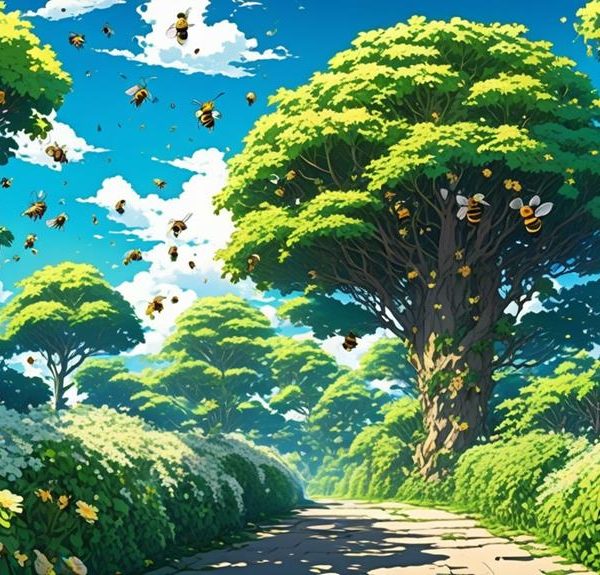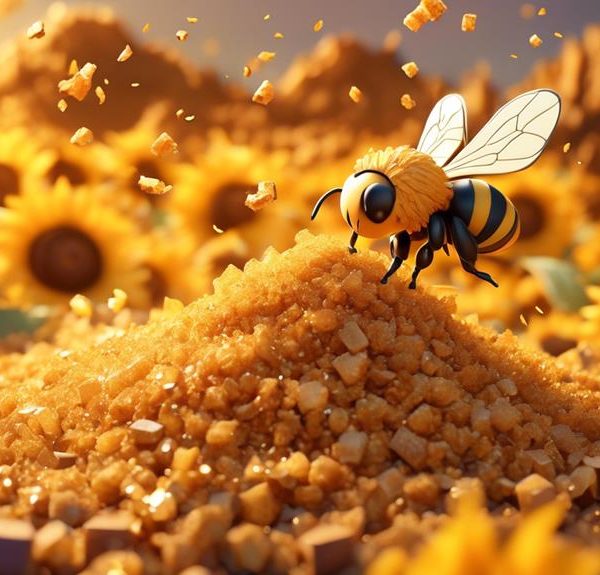Mystery unveils as we delve into the unique relationship between bees and the aromatic Bradford Pear flower; will it be love or repulsion?
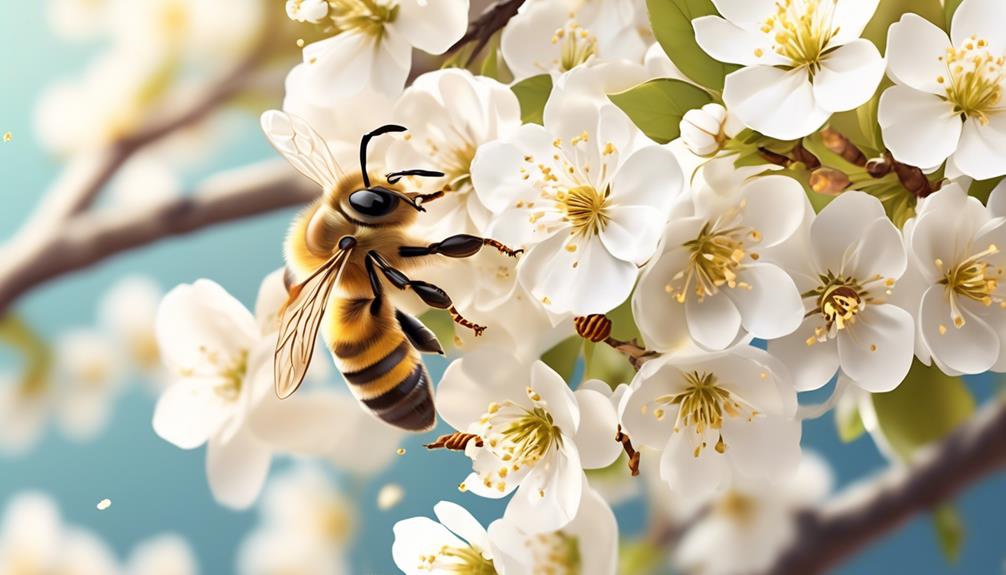
Do Bees Like Bradford Pear Flower
Just as a sommelier discerns the intricate notes and flavors in a fine wine, bees too, have their own preferences when it comes to flowers. Among the myriad of flower choices, the Bradford Pear flower stands out. This white, five-petaled blossom with its distinctive aroma is either a bee's paradise or a complete turn-off.
You might wonder, do bees really fancy the Bradford Pear flower? Or do they find its scent too overwhelming? This intriguing question has led to a fascinating exploration, one that's sure to pique your curiosity and invite further investigation.
Key Takeaways
- Bees are attracted to brightly colored, fragrant blooms, and they are fond of Bradford pear flowers.
- Bradford pear trees bloom early in the spring, providing an abundant source of nectar and pollen for bees.
- Bees play a crucial role in cross-pollinating Bradford pear trees, as the trees rely on bees to transfer pollen from one flower to another for fertilization.
- Planting bee-friendly flowers like Bradford pear can contribute to a healthier ecosystem by supporting bee populations and facilitating plant reproduction.
Understanding Bees and Their Preferences
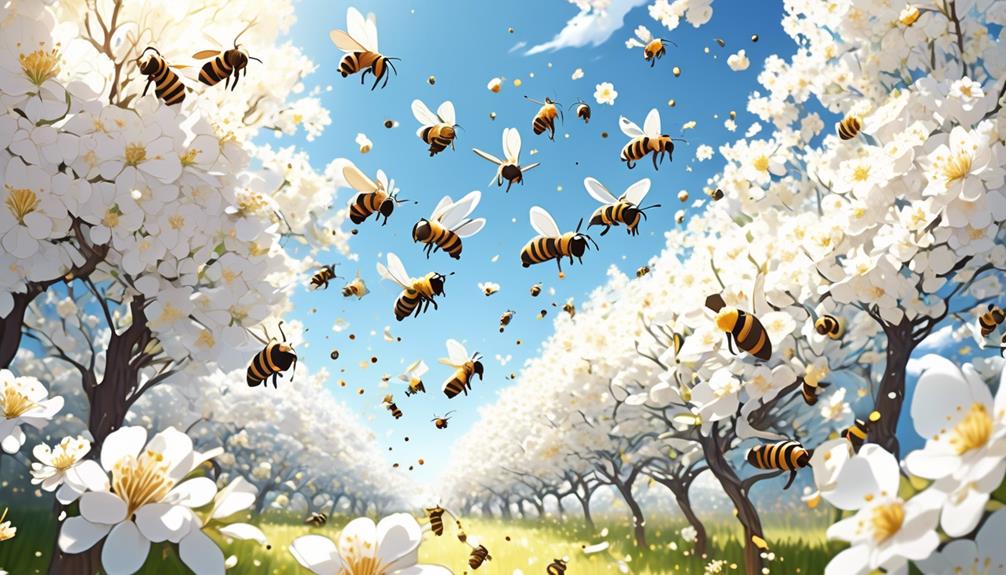
To understand whether bees like Bradford pear flowers, it's crucial to first grasp their innate preferences and behaviors. As a bee, you're driven by a deep biological instinct to seek out nectar-rich flowers. You're attracted to brightly colored, fragrant blooms that provide you with the necessary sustenance to survive and support your hive. Your species communicates through the intricate 'waggle dance', sharing the location of prime nectar sources with your fellow bees.
Bradford pear flowers present an interesting case. They're vibrant and fragrant, which are qualities that you, as a bee, should theoretically find appealing. However, their nectar and pollen content is what truly matters. You're not interested in empty calories, so to speak; you're looking for nutritional value.
Unveiling the Bradford Pear Flower
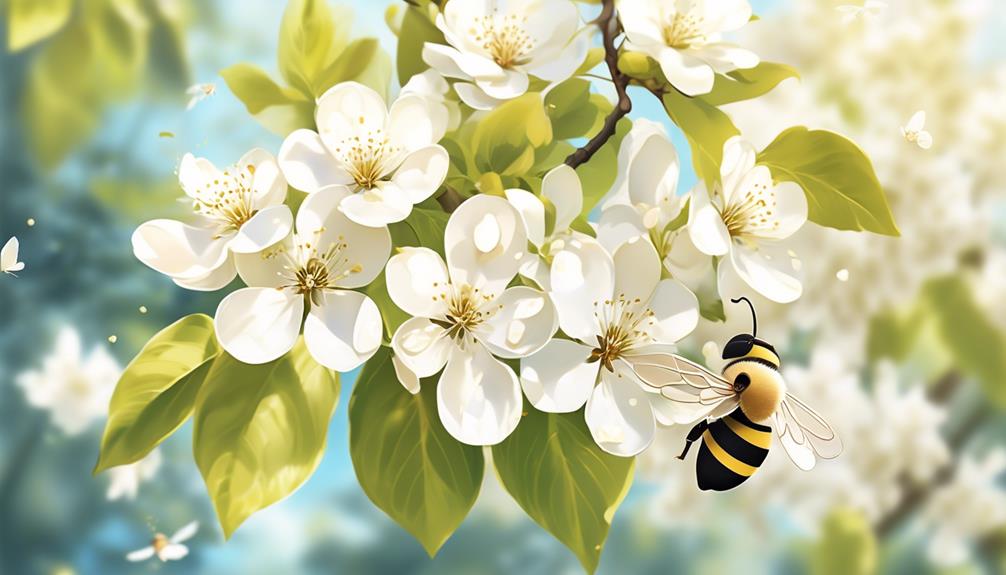
Let's delve into the fascinating world of Bradford pear flowers, known scientifically as Pyrus calleryana, which despite their ornamental charm, have sparked a debate among beekeepers and scientists alike due to their potential nutritional value for bees.
These trees are native to East Asia, but you'll find them dotting the landscapes of North America. They're known for their pyramidal shape, glossy leaves, and the burst of white blossom they present in early spring. As you walk beneath them, you'll notice an unpleasant smell often likened to rotten fish. It's a defense mechanism to deter pests, yet it doesn't seem to deter bees.
The flowers, appearing before leaves, are small and white, grouped in clusters. They're hermaphroditic, possessing both male and female reproductive organs, leading to self-pollination. Yet, they attract bees for cross-pollination, utilizing their nectar as a lure. It's the nectar's composition, though, that's under scrutiny.
While bees are seen buzzing around these blossoms, it's unclear whether the nectar offers substantial nutritional value or merely a quick sugar fix for bees. This uncertainty has triggered a scientific investigation, with implications for beekeeping practices and pollination ecology.
Understanding the Bradford pear flower's relationship with bees, therefore, becomes a matter of both ecological and agricultural significance.
The Link Between Bees and Bradford Pear
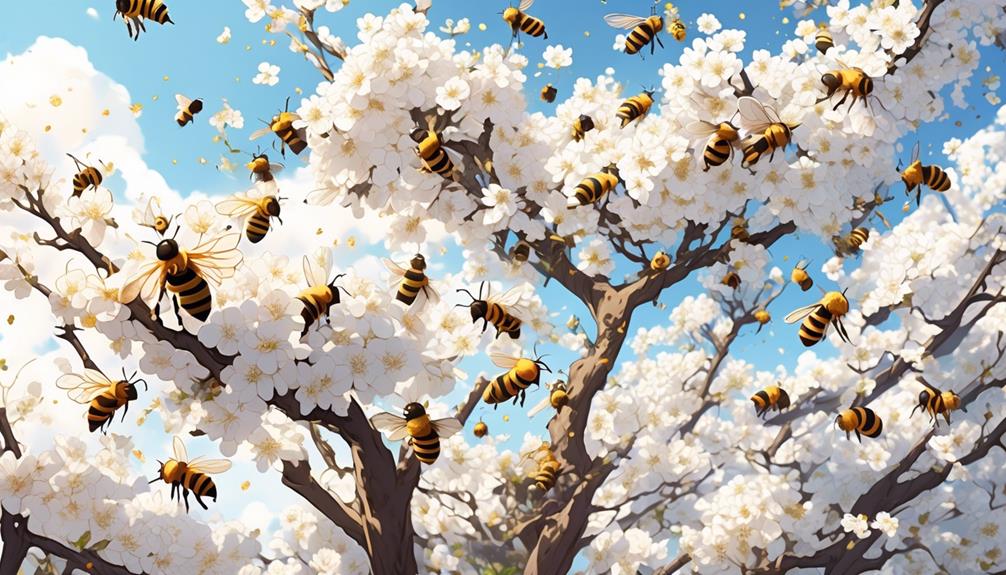
Having explored the unique traits of Bradford pear flowers, you might wonder about their intriguing connection with bees. As it turns out, bees are quite fond of these flowers. Bradford pear trees bloom early in the spring, providing an abundant source of nectar and pollen when many other food sources aren't yet available. Moreover, the tree's white flowers are highly visible, attracting bees from afar.
Bees play a crucial role in Bradford pear tree pollination. You see, these trees are self-sterile, meaning they can't self-pollinate. Instead, they rely heavily on cross-pollination, a process where pollen is transferred from one tree to another, and this is where bees come into the picture. As bees forage for food, they inadvertently transfer pollen from one Bradford pear flower to another, enabling the fertilization necessary for fruit production.
While the relationship between bees and Bradford pear is mutually beneficial, it's not without its complications. The Bradford pear's dense flowering can overwhelm bees, causing them to forage exclusively on these trees and neglect other plants. This can lead to a lack of diversity in their diet, potentially affecting bee health and the pollination of other plants.
Ecological Impact of Bee-Flower Interactions
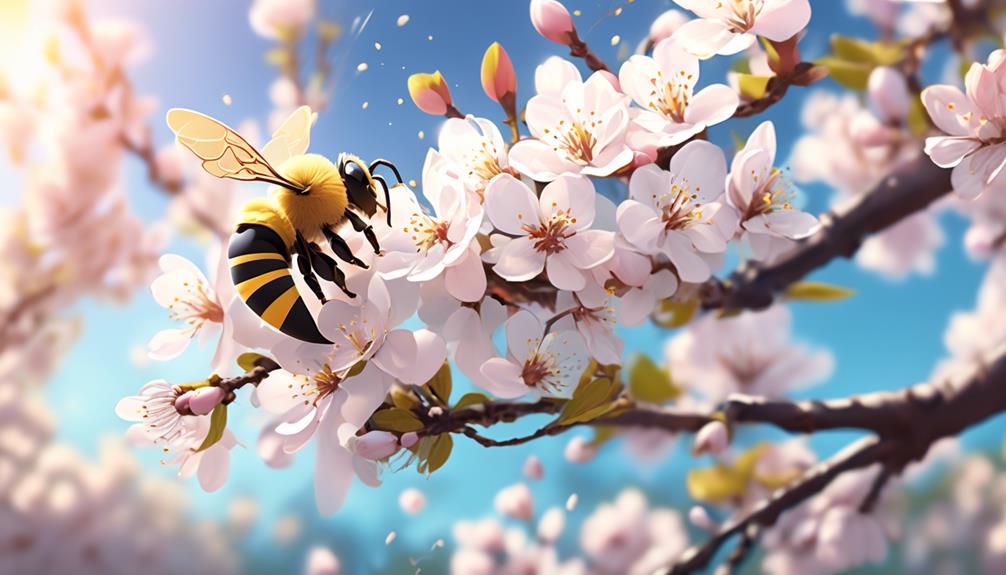
The interactions between bees and flowers, such as those of the Bradford pear, can have profound effects on local ecosystems. Through pollination, bees transfer pollen from the male parts of a flower to the female parts, facilitating plant reproduction. This symbiotic relationship not only benefits bees and plants, but also plays a vital role in maintaining biodiversity.
Let's analyze this further in the table below:
Interaction | Immediate Impact | Long-term Impact |
|---|---|---|
Pollination | Plant reproduction | Biodiversity |
Nectar collection | Bee nutrition | Bee population growth |
Over-pollination | Excessive plant growth | Ecosystem imbalance |
Pollination ensures plant reproduction, leading to biodiversity in the long run. Bees collect nectar for nutrition, which supports their population growth. However, excessive pollination can cause rapid plant growth, potentially leading to an imbalance in the ecosystem if not checked.
As a part of the ecosystem, you play a role in these interactions. Planting bee-friendly flowers like the Bradford pear in your garden can contribute to a healthier, more balanced ecosystem. Remember, the survival of bees and the health of our ecosystems are interconnected.
Conducting Your Own Observations
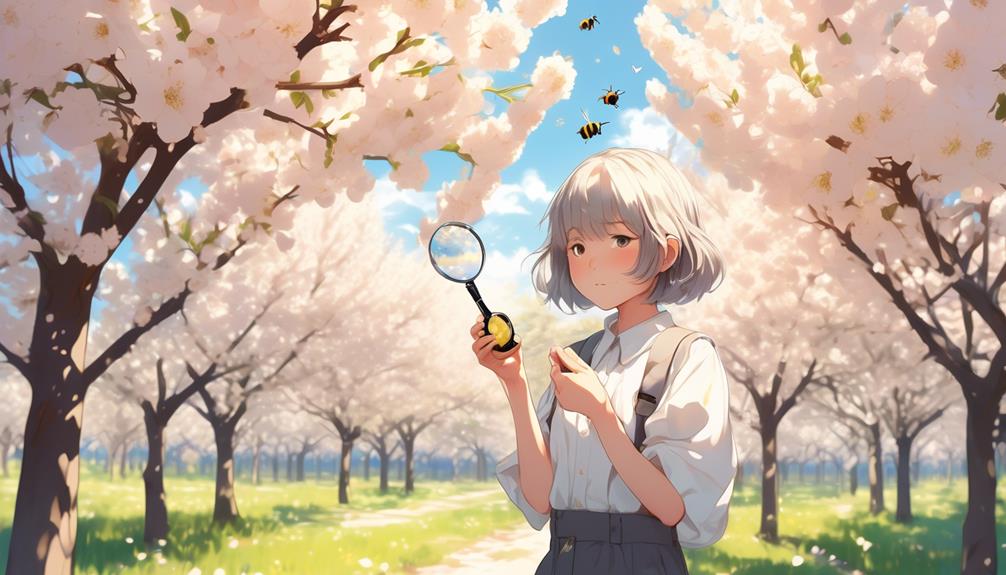
While understanding the ecological significance of bee-flower interactions is crucial, it's equally important to observe these interactions in your own environment, such as watching bees visiting Bradford pear flowers in your garden. Observing can be as simple as sitting quietly in your garden and noting the number of bees that visit the flowers over a set period. It's crucial to note the species of bees, their behavior, and the time spent on each flower.
You can even take a more scientific approach by documenting your observations. Create a chart or a graph to record the frequency and duration of visits, and the specific behavior of bees while on the flower. You might notice patterns or trends over time, such as peak visiting times or preferred flowers.
Photographs can also be a valuable tool. They not only provide visual proof of your observations but can also help you identify bee species.
Frequently Asked Questions
What Other Types of Flowers Are Popular Among Bees Apart From the Bradford Pear?
Besides Bradford Pear flowers, you'll find bees buzzing around many other blossoms. They're particularly fond of asters, sunflowers, and clovers. These provide a rich source of nectar and pollen.
Bees also love lavender, poppies, and marigolds. If you're looking to attract more bees, consider planting these flowers in your garden.
Just remember, not all bees are the same and different species are attracted to different flowers.
How Does the Climate Affect the Interaction Between Bees and Bradford Pear Flowers?
Climate significantly influences the interaction between bees and Bradford pear flowers. If it's colder, bees may not be as active, reducing their pollination. In contrast, warmer temperatures can boost their activity. However, excessive heat might cause the flowers to wilt quickly, shortening the pollination window.
Are There Any Specific Types of Bees That Are More Attracted to Bradford Pear Flowers?
Yes, there are specific types of bees more attracted to Bradford Pear flowers. You'll often see honeybees and bumblebees buzzing around these blossoms. They're drawn to the tree's abundant nectar and pollen.
However, it's not just these bees. Various other pollinators, like butterflies and hummingbirds, also find Bradford Pear flowers irresistible. It's a busy hub of activity in bloom time!
It's crucial to remember, though, that attraction can vary based on local bee species.
Can the Bradford Pear Flower's Nectar Be Harmful to Bees if Consumed in Large Amounts?
You're curious if Bradford pear flower's nectar could harm bees when consumed in large amounts. There's no scientific evidence suggesting it's harmful.
Bees typically collect nectar from a variety of sources, reducing the risk of consuming too much from one plant. However, it's important for bees to have a varied diet, so it's not ideal if a bee's only source of nectar is the Bradford pear flower.
Keep this in mind when planning your garden.
What Are Some Ways to Attract Bees to a Bradford Pear Tree in Your Garden?
Sure, attracting bees to your Bradford pear tree can be beneficial.
Start by avoiding pesticides, which can deter bees.
Planting bee-friendly flowers nearby can also help.
Provide a water source for them, as bees need water too.
Don't prune your tree too much; bees prefer trees with dense foliage.
Lastly, remember that bees are attracted to trees that are in full bloom, so timing is crucial.
Conclusion
In essence, bees do love Bradford Pear flowers! Their nectar-rich blossoms are a feast for these buzzing pollinators. This interaction boosts the tree's propagation and contributes to the overall ecosystem balance.
Yet, remember, nature's preferences can vary across regions. So, why not embark on your own bee-watching escapades to understand these fascinating relationships better? After all, observing is the first step towards understanding our nature's intricate balance.

